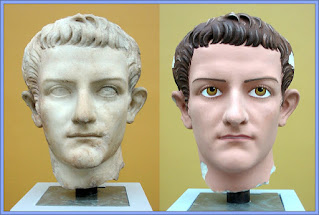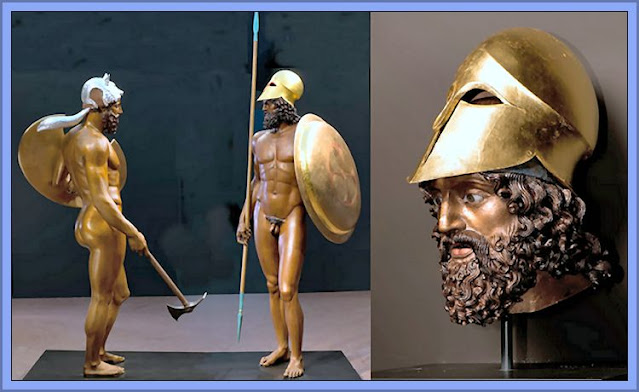 |
| 'Alexander' Sarcophagus - Constantinople (Not His, But Actually One Of His Generals) |
It wasn't the white aesthete look, that the Renaissance artists sought to imitate, when they copied what they thought were original marble statues of antiquity .... they weren't aware of the fact that originally these were coloured. This view that white marble was the ideal condition, led to sculptures actually being cleaned of paint remnants when pulled from the ground.
Much of this cleaning was undertaken because Johann Joachim Winckelmann, a German art historian and archaeologist who was one the early enlightenment Hellenists, pronounced that "The whiter the body is, the more beautiful it is as well. Colour contributes to beauty, but it is not beauty. Colour should have a minor part in the consideration of beauty, because it is not (colour) but structure that constitutes its essence." .... this view stuck.
 |
| Thalia - Delos 2nd century BC (Shows original paint) and Trojan Archer - Aegina, Greece 480 BC (aka 'Paris') |
This ignored a voice from the past - Euripides - in the play Helen of Troy:
....... to wipe a statue of its colour is actually to disfigure it in the thoughts of the time.
Winckelmann was actually well aware of the historical evidence that sculptures were once colourful, as some discoveries he saw even had some paint left on them. But he preferred his own opinion on the value the statues as pristine canvasses for perfection .... thus setting the scene for the ancient aesthetic to be white marble for the next 250 years.
 |
| Statue of Emperor Augustus from Prima Porta |
Recent technology changes, including a technique called raking light, mean that in many cases we can now visualise exactly what the sculptures looked like when painted. These were originally painted in dazzling and powerful hues - from red ochre and cinnabar, to azurite and malachite. So a growing movement has developed, to consider the actions of archaeologists from the 19th and 20th century, who actually 'cleaned' some of their discoveries to remove paint evidence, to be cultural vandalism.
 |
| Emperor Caligula .... |
Now various art historians have attempted to revive the peacock glory that was Greece (and other ancient art works), by reproducing sculptures and frescoes in full colour.
 |
| The Riace Warriors - Made Around 460 BC - They Are High Quality Exports to Italy Much of Which Had Greek Colonies. |
Many of the reproductions are hand-painted in the same mineral and organic pigments used by the ancients: With natural pigments mixed in egg tempera; green from malachite, blue from azurite, yellow and ochre from arsenic compounds, red from cinnabar, black from burned bone and vine. Some, such as the Riace Warriors are still beautiful, but as they were highest grade bronze exports for a temple, that's perhaps not surprising.
However many are shocking to our eyes .... but remember, many were painted to be seen from 50 feet away on the ground, or by the light of flickering temple braziers. They were the photographs of the day, for people who never saw the gods, or their rulers.
Still, as I have remarked before .... what a sight and spectacle it would have been.

I love how gaudy they are. I bought plastic toys this colour 20 years ago, Which suggests that the real colours were known decades ago.
ReplyDeleteThanks for the comment. Do you know what, now that you have made me think about it I dis indeed have some plastic model Spartan warriors who were similar to these. And that was (ahem, ) several decades ago. So I guess the makers were just guessing or they did some research.
DeletePlastic Old Soldiers 1
Plastic Old Soldiers 2
Plastic Old Soldiers 3
Plastic Old Soldiers 4 - 1950's
and
a page of them
The past is increasingly being digitised and recreated as it was.
ReplyDelete